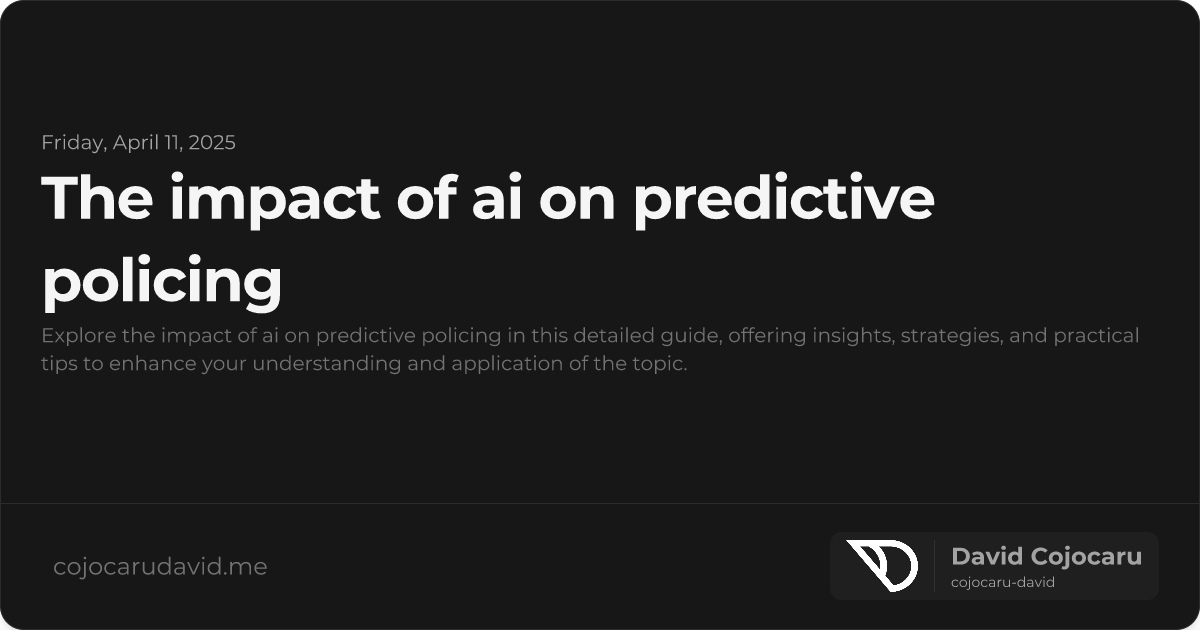The Promise and Peril of AI in Predictive Policing
Artificial intelligence (AI) is rapidly transforming law enforcement, and nowhere is this more evident than in predictive policing. The impact of AI on predictive policing is significant, offering the potential to anticipate and prevent crime with unprecedented accuracy. But this powerful technology also presents serious ethical challenges, demanding careful consideration and robust safeguards. AI-driven algorithms now analyze massive datasets, from crime reports to social media trends, to forecast where and when crime is likely to occur. While proponents tout increased efficiency and reduced bias, critics raise concerns about fairness, transparency, and potential misuse. Is AI a revolutionary tool for safer communities, or a threat to civil liberties?
How AI is Reshaping Crime Prediction
AI enhances predictive policing by dramatically improving accuracy, speed, and scalability. Unlike traditional methods that rely solely on historical crime data, AI incorporates a wide range of real-time inputs, including weather patterns, economic indicators, and social media activity. This holistic approach provides a more nuanced and dynamic understanding of crime patterns.
Key Advantages of AI in Fighting Crime
- Lightning-Fast Data Analysis: AI can sift through millions of records in mere seconds, identifying subtle patterns and anomalies that human analysts might miss. This speed is crucial for responding quickly to emerging threats.
- Strategic Resource Allocation: Police departments can optimize officer deployment based on AI-generated risk maps, ensuring that resources are directed to the areas where they are most needed, maximizing their impact.
- Proactive Crime Prevention: By flagging high-risk areas before crimes occur, AI enables preemptive interventions, disrupting criminal activity and preventing harm.
Real-World Examples of AI-Powered Policing
Law enforcement agencies are increasingly adopting AI-driven platforms like PredPol and HunchLab. These tools leverage machine learning algorithms to predict hotspots for burglaries, assaults, and other crimes, allowing officers to focus their efforts on prevention.
The Ethical Minefield of AI Policing
Despite its potential benefits, the use of AI in predictive policing raises a number of critical ethical questions.
The Danger of Bias and Discrimination
AI models are only as good as the data they are trained on. If that data reflects existing biases – such as historical over-policing of minority neighborhoods – the AI will perpetuate and even amplify those biases. This can lead to skewed predictions that unfairly target specific communities, reinforcing harmful stereotypes.
The Problem of “Black Box” Algorithms
Many AI systems operate as “black boxes,” making it difficult or impossible to understand how they arrive at their conclusions. This lack of transparency makes it challenging to audit their decision-making processes and hold them accountable for errors or biases.
The Threat to Privacy and Civil Liberties
The use of surveillance data, facial recognition technology, and social media monitoring in predictive policing raises serious concerns about privacy violations and potential infringements on civil liberties. The line between legitimate crime prevention and unwarranted surveillance is increasingly blurred.
Charting a Course Towards Ethical AI
To responsibly harness the power of AI in predictive policing, policymakers, technologists, and community stakeholders must collaborate to establish clear safeguards.
Essential Steps for Ethical AI Policing
- Bias Mitigation Strategies: Implement rigorous processes to regularly audit datasets and algorithms for fairness, identifying and correcting any biases that may be present.
- Meaningful Public Oversight: Involve community members in decisions about AI deployment, ensuring that their voices are heard and their concerns are addressed.
- Comprehensive Regulatory Frameworks: Enact laws and regulations that govern the use of AI in law enforcement, protecting civil rights and ensuring accountability.
The Future Landscape of AI in Law Enforcement
As AI technology continues to evolve, predictive policing will undoubtedly become more sophisticated. However, realizing its full potential requires a commitment to fairness, transparency, and accountability.
“AI in predictive policing is not solely about technology; it’s fundamentally about building trust. Without a firm foundation of fairness and transparency, even the most technologically advanced systems are destined to fail.”
Conclusion: Responsible Innovation is Key
The impact of AI on predictive policing is undeniable, presenting both unprecedented opportunities to enhance public safety and significant ethical challenges. By proactively addressing bias, prioritizing transparency, and fostering genuine accountability, we can leverage the power of AI to create safer communities without sacrificing fundamental civil rights. The future of policing hinges on our ability to embrace responsible innovation and ensure that AI serves justice, not the other way around.

